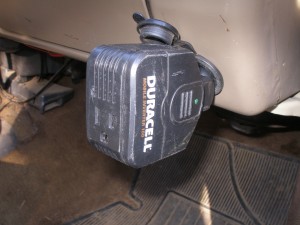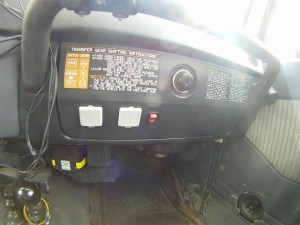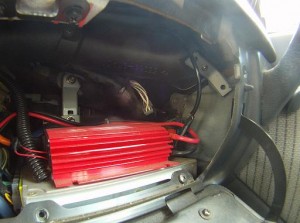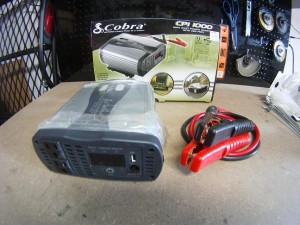By Eric B and Tony K
In this modern era we live in electronics have heavily intruded on our lives and this tranlates frequently to a need for power on the road and trail other than 12vDC. But fortunately inverters of all sizes are readily available. There are lots of options out there, just depends on your needs.
Small and Simple
 When we bought a new camera we could no longer use the AA charger I have in my rig. It came with a specialized battery that only had a charger that plugged into a wall outlet. But a handy solution presented itself in the form of a 100 watt inverter that plugs into one of my DC outlets. While the output is minimal it works just fine for the camera battery. Bought an extra battery that can be charging while the other is in use.
When we bought a new camera we could no longer use the AA charger I have in my rig. It came with a specialized battery that only had a charger that plugged into a wall outlet. But a handy solution presented itself in the form of a 100 watt inverter that plugs into one of my DC outlets. While the output is minimal it works just fine for the camera battery. Bought an extra battery that can be charging while the other is in use.
Also noticed this thing has a USB charge port. This will come in very handy for the GoPro camera I just added to my rig. The only way to charge the lithium battery is by way of a USB outlet.
Medium Output
 Other equipment requires a bit more juice to run properly. Inverters of around 400 to 800 watts fall into this category. Eric has one of these mounted in what used to be the glove box, the two white squares in the pic are the outlets for it. Most laptops can be charged with this size of an inverter. To find out if it will work on yours look at the voltage requirements on your charge cord. Surprisingly it doesn’t take 120VAC to charge them, the box in the cord converts the power to DC. Usually around 19V and somewhere between 4 and 7 amps. Which is not all that much of a draw on your batteries.
Other equipment requires a bit more juice to run properly. Inverters of around 400 to 800 watts fall into this category. Eric has one of these mounted in what used to be the glove box, the two white squares in the pic are the outlets for it. Most laptops can be charged with this size of an inverter. To find out if it will work on yours look at the voltage requirements on your charge cord. Surprisingly it doesn’t take 120VAC to charge them, the box in the cord converts the power to DC. Usually around 19V and somewhere between 4 and 7 amps. Which is not all that much of a draw on your batteries.
Running Tools
While we don’t exactly run service trucks, tools usually have a much larger draw that requires a larger output inverter. If you want to run power tools, especially variable speed ones, you will need at least 1000 watts of continuous rated output. Most inverters are also have a surge rating that is usually double the continuous rating. When you first ![]() pull the trigger switch on tools their is a surge load that is quite a bit higher than the running load. So you need to make sure your inverter will handle the surge load as well as the running load. Also consider the draw of the tool while using it, this also goes up as you put a load on the working end of a tool. Bind up a drill or press hard with the grinder and the required power goes up.
pull the trigger switch on tools their is a surge load that is quite a bit higher than the running load. So you need to make sure your inverter will handle the surge load as well as the running load. Also consider the draw of the tool while using it, this also goes up as you put a load on the working end of a tool. Bind up a drill or press hard with the grinder and the required power goes up.
Some drills and grinders may run on less, but when a load is put on them the inverter will fault. This particular inverter was brought by our friend James on the Rubicon Trail. I was the lucky one to need it as I had needed to use a grinder and a drill on the trail. The first thing I did when I got home was go out and by one for myself.

